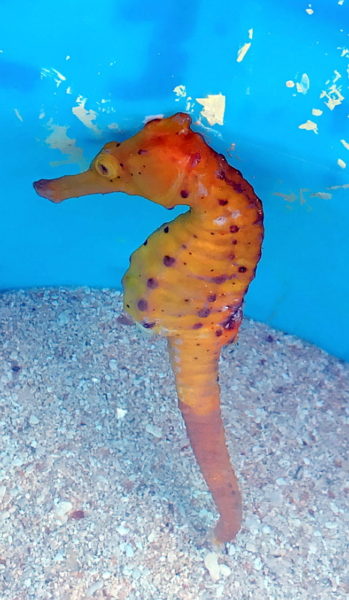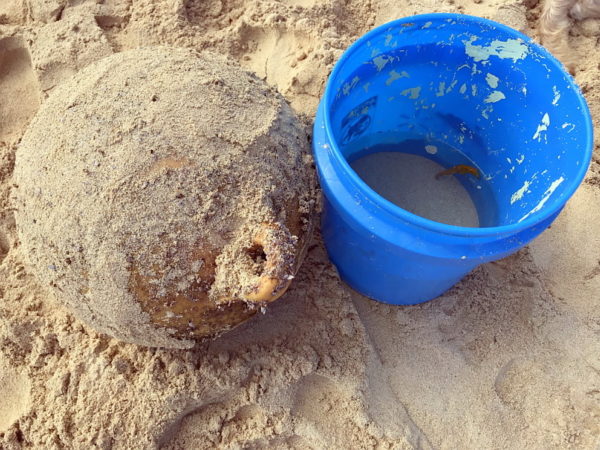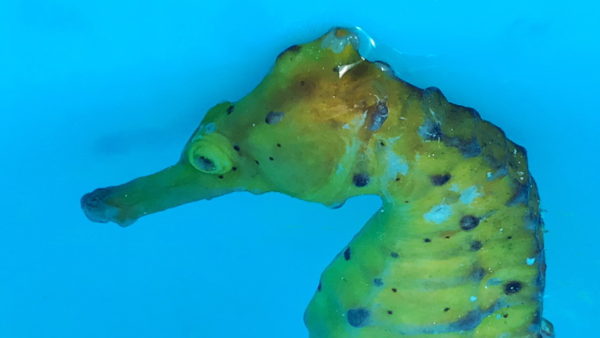Published in the Ocean Watch column, Honolulu Star-Advertiser © Susan Scott
January 20, 2018
I could practically hear the yippees in Jeanine Palmieri’s email when I read her account of what she and her husband found at Bellows Beach on Martin Luther King Day. “We were in the right place at the right time,” Jeanine wrote, “to see this little feat of Mother Nature!”
What the couple saw was two children looking into an old paint bucket in the sand. Next to the bucket lay a basketball- size fishing float covered in goose barnacles, seaweed and other marine growth.
 As slow swimmers, sea horses hide and
As slow swimmers, sea horses hide and
remain motionless as a defense from predators.
Courtesy Jeanine Palmieri.
The boy had spotted the black plastic ball in the waves and swam out to retrieve it so it wouldn’t hit anyone. Once ashore, the boy and his sister noticed a crab on the float. And on the crab clung a stunning sea horse.
The sea horse is a Hawaii native. The smooth sea horse’s scientific name is Hippocampus kuda. In Greek mythology, hippocampus was a sea monster with the head of a horse and the tail of a fish. All monsters should be so enchanting.
Hawaii fish guidebooks usually list three sea horse species and three pipefish species because the two fish types are closely related. Pipefish look like stretched-out sea horses.
 Seahorse in old paint bucket.
Seahorse in old paint bucket.
Courtesy Jeanine Palmieri.
But even though six of these beauties swim in Hawaii waters, we snorkelers and divers are lucky if we see any in our lifetimes. The fish are only 3 to 6 inches long and are well camouflaged. As slow swimmers, sea horses and pipefish hide and remain motionless as a defense from predators.
Another defense is a suit of armor that encloses the body. Some sea horses have spikes on their armor’s rings and ridges, but others are smooth. This is where Hawaii’s smooth sea horse, our most common, gets its name.
I use the word “common” loosely because Hawaii’s sea horses appear and disappear over the years. In the summer of 2012 I found seahorses in one area on the North Shore, in about three feet of water, nearly every time I snorkeled there. It didn’t last. After a series of huge surf events that winter, I never saw my little ponies again.
Jeanine called the Waikiki Aquarium about the rare finding at Bellows. Staff there said if the sea horse looked healthy, and it did, to return it to the ocean.
If you get lucky and find a sea horse, admire it, take pictures and then please return it gently to its natural habitat.
Putting a wild sea horse in your home aquarium is a death sentence for the little beauty.
Continuing the story, Jeanine wrote that even though the young boy wanted to keep the sea horse as a pet, “his dad took the bucket far beyond the surf and let the sea horse run free.”
This story has a nice ending and a moral, too: When you see people at a shoreline peering into a container, always take a look. Inside Hawaii beach buckets, there may be magic.
You can enjoy sea horses galore anytime at the Waikiki Aquarium’s seahorse exhibit and nursery.
